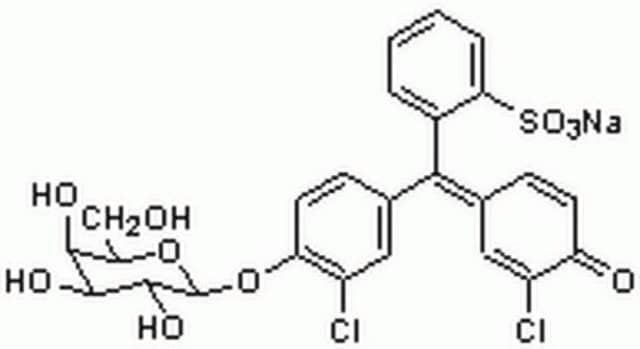199524
Chlorophenol Red
indicator grade
Synonym(s):
3′,3′-Dichlorophenolsulfonaphthalein
About This Item
Recommended Products
grade
indicator grade
form
powder, crystals or chunks
color
dark brown
pH
4.8-6.7, yellow to violet
solubility
95% ethanol: 10 mg/mL
λmax
572 nm
ε (extinction coefficient)
≥12000 at 295-301 nm in 0.1 M NaOH
≥45000 at 573-579 nm in 0.1 M NaOH
≥5000 at 368-374 nm in 0.1 M NaOH
application(s)
diagnostic assay manufacturing
hematology
histology
storage temp.
room temp
SMILES string
Oc1ccc(cc1Cl)C2(OS(=O)(=O)c3ccccc23)c4ccc(O)c(Cl)c4
InChI
1S/C19H12Cl2O5S/c20-14-9-11(5-7-16(14)22)19(12-6-8-17(23)15(21)10-12)13-3-1-2-4-18(13)27(24,25)26-19/h1-10,22-23H
InChI key
WWAABJGNHFGXSJ-UHFFFAOYSA-N
Looking for similar products? Visit Product Comparison Guide
Related Categories
Biochem/physiol Actions
signalword
Warning
hcodes
Hazard Classifications
Eye Irrit. 2 - Skin Irrit. 2 - STOT SE 3
target_organs
Respiratory system
Storage Class
11 - Combustible Solids
wgk_germany
WGK 3
flash_point_f
Not applicable
flash_point_c
Not applicable
ppe
dust mask type N95 (US), Eyeshields, Gloves
Certificates of Analysis (COA)
Search for Certificates of Analysis (COA) by entering the products Lot/Batch Number. Lot and Batch Numbers can be found on a product’s label following the words ‘Lot’ or ‘Batch’.
Already Own This Product?
Find documentation for the products that you have recently purchased in the Document Library.
Customers Also Viewed
Our team of scientists has experience in all areas of research including Life Science, Material Science, Chemical Synthesis, Chromatography, Analytical and many others.
Contact Technical Service










